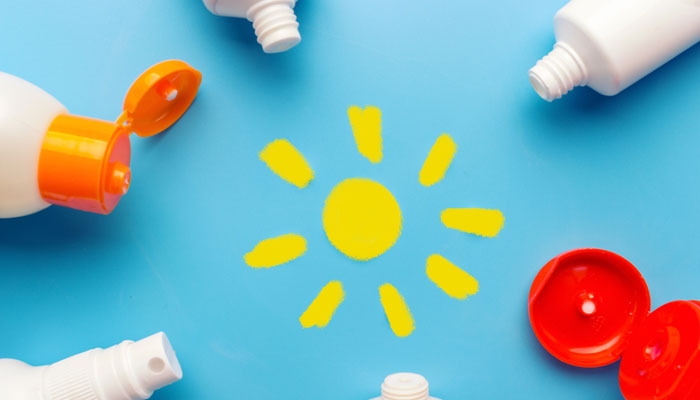
No more excuses for why you can't cover up
Myth #1
“The chemicals in sunscreen are probably more dangerous than sun exposure”
It’s unfortunate that sunscreens—that protect you from not just sunburn, rashes, cell and tissue damage but unsightly premature wrinkling and skin cancer—have received such bad press. These safety concerns don’t apply to humans at all. There are two types of sunscreens; physical and chemical. The first are made of non-organic pigments like zinc oxide or titanium dioxide, which reflect or diffuses the radiation. Since these are chemically inert, they do not produce allergies, and work immediately. But they do give a chalky appearance to the skin. Remember Andrew Symonds white lips?
Chemical sunscreens contain chemical UVB-filters like octyl triazone, urocanic acid, octyl methoxycinnamate, methylbenzylidene camphor, 3-benzylidene sulfonic acid, and PABA.
Newer sun protection also contain UVA-filters, such as benzophenone-3, benzophenone-4 butyl methoxydibenzoylmethane and terephthalylidene sulfonic acid. To further diminish the destructive effects of UV-induced oxygen radicals, antioxidants like vitamins (A, E, C), minerals (selenium and zinc) or reduced glutathione are often added to sunscreens. None of these chemicals have been known to have harmful side effects.
However, skin allergies arising from sunscreen use have often been reported. While the incidence of hypersensitivity reactions to sunscreens is very low, para-aminobenzoic acid (PABA) is usually the culprit. PABA is used not just in sunscreen buts also in many preservatives and fragrances, and is believed to be responsible in 30 per cent and 25 per cent of cases of cosmetic-related contact dermatitis, respectively.
Just to be sure, before slathering on a new sunscreen entrant this summer, visit a dermatologist and get a patch test done to determine if it suits you or not.
Myth #2
“I don’t get a lot of sun”
The fact is that unprotected skin can burn in minutes. Most people incorrectly assume that dry skin leads to wrinkles and simply slathering on moisturizers will keep them looking young and supple. Actually, research shows that a whopping ninety percent of wrinkles are caused by the sun’s UVA light. Even at low-level exposures, UVA light breaks down collagen, which causes wrinkles. Sun damage is the number one cause of leathery skin and premature aging in women and men. Everyone should use a broad spectrum sunscreen with an SPF of at least 15 to 30 all of the time, indoors and outdoors, even on cloudy days. Clouds don’t block the UV rays that cause sunburn, so you can still get sunburnt. Just remember, UV rays can be reflected off water, sand, snow, glass and concrete. So you can even get sunburn in the shade.
Myth #3
“Applying sunscreen leaves a white film on my face which makes me look bad”
The reason for the chalky look is the zinc oxide or titanium dioxide in the sunscreen you are using. Instead of doing away with sunscreens altogether, why don’t you look for one that works for you? Most people benefit from sunscreens with sun protection factor (SPF) numbers of 15 or more. For example, if you burn in 10 minutes without sunscreen and you apply a liberal dose with a SPF number of 15, you should be protected from sunburn for 150 minutes. There are dozens of different brands in the market today. Just shop around for one with a (SPF) of 15 or higher. It should give you broad-spectrum protection against ultraviolet A (UVA) and ultraviolet B (UVB). Check for broad spectrum agents including benzophenones (oxybenzone), cinnamates (octylmethyl cinnamate and cinoxate), sulisobenzone, salicylates, titanium dioxide, zinc oxide, and avobenzone (Parsol 1789).
Anthelios by La Roche Posay, Photoderm by Bioderma, Neutrogena Ultra sheer are some of the good broad spectrum sunscreens.
Myth #4
“I use a day cream with SPF, so I don’t need a sunscreen”
If you are skipping using a sunscreen because your day cream has a SPF, you are unwittingly exposing your skin to harmful broad-spectrum UV rays. A new study recently published in the Archives of Dermatology reported that many top selling day creams that claim to offer protection from harmful UVA rays don’t contain the necessary ingredients. Even worse, if they do, they are usually not present in sufficient quantities to afford any real protection.
The study specifically looked for UVA filters such as avobenzone, octocrylene, ecamsule (also known as Mexoryl SA) and zinc oxide in 29 of the best-selling day creams in the US. The data was revealing: Six of the 29 creams didn’t contain anyactive ingredients to provide UVA protection. Seven contained zinc oxide, but only three had enough to adequately protect skin; 16 others contained avobenzone, but only three of them contained the level of octocrylene needed to stabilize the ingredient. Just keep that in mind before doing away with your daily sunscreen.
Nykaa Recommends: Banana Boat Ultra Protect Sunscreen Lotion PA+++ SPF 30, Neutrogena UltraSheer Dry Touch Sunblock SPF 50+, Lotus Herbals Safe Sun 3-in-1 Matte-Look Daily Sun Block Pa+++ SPF- 40, Ponds Sun Protect Non-Oily Sunscreen SPF 30, L'Oreal Paris UV Perfect Super Aqua Essence SPF 50+ PA++++ Long UVA

